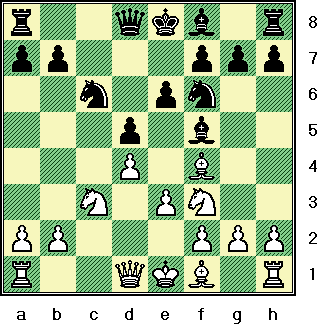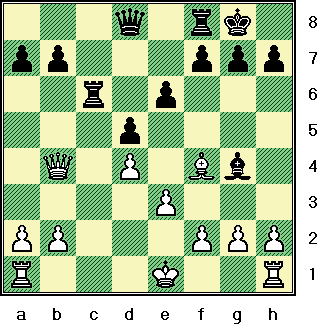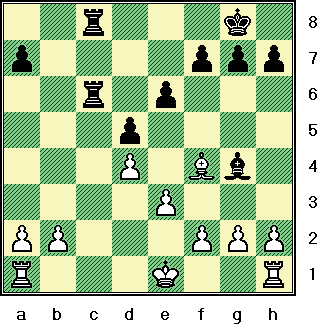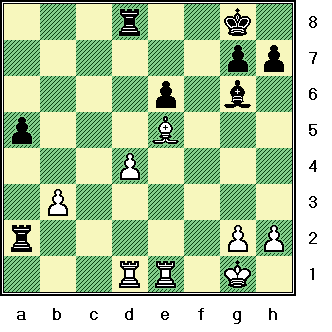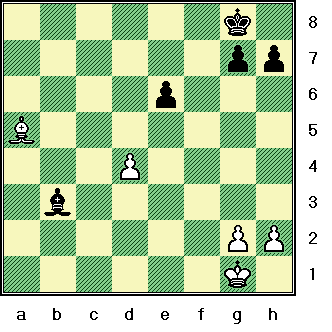All
the |
(Navigation bar
directly below.)
*******
© A.J. Goldsby, 2015.
(All rights reserved.)
****************
Click HERE
to see my
Chess Items.
****************
****************
Buy a book
from Amazon.com
(And help me out as well!)
****************
Click HERE
...
to see a list of the businesses that help to sponsor all of
my chess efforts.
|
|
The World Championships, 2008
Replay this game here,
(but on the popular "Chess Games" website).
An
explanation of the symbols that I use
when annotating a chess game.
NOTE: My primary aim here was try to explain the logic of the moves to any average player. I was not interested in copying someone else's work or echoing the popular opinion.
GM
Vladimir Kramnik (2772) - GM
Viswanathan Anand (2783)
|
|
|
8.Qb3, ('!')
This might be the only good way for White to try and increase the pressure.
[
Instead, after the continuation of: 8.Bd3 Bxd3; 9.Qxd3 Bd6; 10.Bxd6 Qxd6; 11.0-0
0-0; "="
the draw is virtually guaranteed.
(This is the #1 continuation given by the 2008 "Power-Book," there
were 969 examples in the on-line
database, and the first 20-30 that I looked at were all draws!)
The highest rated example that I could find in the DB was:
GM Alexander Khalifman (2655) -
GM Vladimir Epishin (2570); [D14]
Bayern-chI; 1st Hofmann Bank
/ Bad Wiessee, (R#9); GER / 1997.
(A draw, 1/2 - 1/2 in only twelve
{12} total moves.)
******************************************************************************************************************
The "Chess Player's Bible" gives the following continuation:
8.Bb5 Nd7; 9.Qa4 Rc8; 10.0-0!, This is probably best.
(</=
10.Bxc6?! Rxc6!; 11.Qxa7!? Bd3!; "=/+")
10...a6; The end of the column.
11.Bxc6!?, (Hmmm.) I am not sure about this.
(Maybe better was: 11.Be2!? , "=" )
11...Rxc6; 12.Rfc1 Be7; 13.Nd1 b5; 14.Qb3 Rc4; 15.Nd2 Rxc1;
16.Rxc1 0-0;
17.Qc3 b4; 18.Qc6 Bd3; "=" with an equal game.
Vladimir Kramnik (2455) - Sergei Rublevsky (2300); [D14]
/ The "Under-20" Championship
Simferopol, U.S.S.R.; 01,1990. (Draw, 1/2 in just 24 total moves.)
[ See MCO-15; page # 486; column # 70-72 and all relevant
notes.
Especially see col. # 70, and also note # (p.) here. ]
]
8...Bb4;
This is correct, after a move like 8...Qb6?!; Black gets a hideous pawn structure.
(Doubled and
isolated b-Pawns.)
And after
8...Qc8!?; ('?!') then 9.Rc1, "+/=" is rather awkward for the second player.
(And 8...Rb8?? is lame, then White just plays 9.BxR/b8, "+/-" winning.)
[ Of course Anand would never play a continuation like: </= 8...b6??; because of the simple line:
9.Bb5 Rc8; 10.Ne5, "+/-" and Black is losing material.
***************************************************************************************************************
After a move like: </= 8...Qd7?; 9.Ne5 Qc8[]; Forced.
(Instead after the continuation of: </=
9...Nxe5??; 10.dxe5 Ne4; 11.Bb5, "+/-" Black loses the Q. )
10.Rc1, ± ("/+")
White has strong pressure. ]
9.Bb5,
This pin could be the only viable attempt by Kramnik if he is really interested in trying to win this game.
[Or 9.Ne5, Qb6!]
[ After the following continuation:
RR
9.Be2 0-0; 10.0-0 Qe7; "="
the second player should not feel that he is under any duress.
]
9...0-0; 10.Bxc6 Bxc3+[]; (Forced.)
Obviously not 10...bxc6??; because of the simple move, 11.QxB/b4. "+/-"
11.Qxc3, (Best? The box thinks so.)
This is probably the sharpest, however it was not the only way to go.
[
Another possibility was:
RR
11.bxc3 bxc6; 12.Ne5, "/\" but Kramnik may have been
concerned about Anand
trying to exploit his weak c-Pawn and the fact that the White King hasn't castled yet.
]
The next few moves are probably close to being forced, and are probably best.
11...Rc8;
12.Ne5 Ng4; 13.Nxg4 Bxg4; 14.Qb4! Rxc6!;
{See the diagram just below.}
Rather than play ...bxc6; and stubbornly keep the Pawn, Anand goes for active play instead.
[
Perhaps less attractive for Black was the following continuation:
(</=) 14...bxc6 ; 15.Bd6 Re8 ; 16.0-0,
"+/=" (+ "/\" or the initiative)
when White can generate some pressure on the dark squares and
against Black's backward c-Pawn.
]
|
|
15.Qxb7, (TN?)
Apparently this is a new move, as far as I can tell, no one - (at the Master level) -
had ever tried this testing capture prior to this particular contest.
[ The move of 15.0-0 had been played before, in the contest: A. Nussbaecher (2120) - T. Seibold (2105);
Landesliga Sued 0102 / Bayern, (R#9); GER: 07,10,2001. ]
[ RR 15.0-0 Qd7; 16.Rac1, Rfc8; "=" ]
Now
Black chooses active play over passive defense.
15...Qc8!; 16.Qxc8[],
Of course, White had no choice here. (</= 16.QxP/a7??, Rc1+; is suicide.)
[ RR </= 16.Qb3? Qa6!; "/+" (Maybe "-/+") ]
16...Rfxc8;
{See the diagram just below.}
Black has good "comp," and there are also opposite colored Bishops as well. (Dynamic equality.)
|
|
17.0-0 a5;
(Maybe - '!')
This is a good move ... the main idea is to restrain White's pawn majority on
the a and b-files. (Most programs prefer 17...Be2 here.)
18.f3 Bf5;
19.Rfe1 Bg6; 20.b3,
This looks awkward, but otherwise how does White proceed with the defense of his position? (Note that while the Black Bishop is on the h7-b1
diagonal, White will find it impossible to play Rb1. Since an eventual ...Rc2; cannot be prevented, White must figure out how he is going to defend his
button that was on b2.)
[ RR 20.Re2 Rc2; 21.Rae1 Bd3; "<=>" ]
20...f6; (e5 + space)
This keeps White's Bishop off at least two key squares and also relieves GM Anand from having to worry about a later "back-rank" mate. (It also
prepares later pawn moves like ...e6-e5; or even ...g7-g5.)
21.e4!?,
This looks inadvisable, as the more the White Pawn structure gets broken up, the easier Black will find it to target White's Pawns and generate
counterplay. However, White is at a loss for good (alternative) moves. [And now that Kramnik can control c1 with his Bishop, he is preparing Rc1 to
challenge Anand's control of the only open file.]
[ Instead after the moves:
21.h4 Kf7; 22.Rf1 Rc2; "~" Black holds the balance by virtue
of his
extremely active position and the presence of the opposite colored Bishops in the coming endgame.
]
21...dxe4; 22.fxe4 Rd8;
23.Rad1 Rc2; 24.e5,
This looks like a poor idea, yet Kramnik could not wait around too long. (See the variation given just below.)
[
Instead, after the following continuation:
24.a4!? e5!;
25.dxe5 Rxd1;
26.Rxd1 fxe5; 27.Bxe5 Bxe4; "<=>"
("=")
Black is in no danger of losing.
]
24...fxe5; 25.Bxe5 Rxa2; "="
{See the diagram just below.}
Anand has regained his Pawn and no longer has anything to worry about. (In fact, I like Black here. And if White were to "dilly-dally" and give Black the time to play ...R/d8-c8-c2; then the first party would be lost.)
|
|
3r2k1/6pp/4p1b1/p3B3/3P4/1P6/r5PP/3RR1K1 W/m26
This is the current position that we have on the chessboard.
Now both Rc1 (and the text) work to
relieve some of the pressure.
26.Ra1 Rxa1; 27.Rxa1 Rd5;
28.Rc1 Rd7[]; This was forced.
(Black did not want to allow White to be able to play Rd7, when the second player has no way to guard the sensitive g7-square.)
29.Rc5 Ra7; 30.Rc7,
('!?')
This forces further simplification, but there was no way for White to try and (slowly) improve his position. Therefore, Kramnik decides to allow the position to be reduced even more.
[ Or 30.Kf2 Be4; "=" - Fritz 11;
********************************************************************************
Also, the following variation:
30.Bb8!? Rb7; 31.Bc7 Rxb3;
32.Rxa5 Be4; "<=>" (counterplay)
did not allow White any realistic hope of winning the game, either.
]
The last few moves are both best and
mostly forced.
30...Rxc7; 31.Bxc7 Bc2; 32.Bxa5 Bxb3; "=" {See
the diagram just below.}
And here the players agreed to a draw, to play on any further would be both anticlimactic ... and just plain silly.
|
|
An entertaining draw ... but it was obvious to most - from the very outset of this game - that neither party wanted to risk a great deal in the very first game of the match. (Please note that the equilibrium of the position was never seriously disturbed.)
For some good analysis of this game,
please see the following link: http://www.chessbase.com/newsdetail.asp?newsid=4958
[You can see a good analysis of the
game. There is a link to a replay page. You can also download IM M. Pein's
analysis (in PGN format) to your computer as well.]
This
is the "Chess Games" link
on this match. (http://www.chessgames.com/perl/chess.pl?tid=65865.)
(Lots of analysis, comments, and many interesting links!)
Copyright (c) A.J. Goldsby, 2008. All rights reserved.
½-½
Download all the games of this match, in PGN format, annotated by IM M. Pein.
Click HERE to return to my home page.
Click HERE to go/return to my "Best Games" page.
Click HERE to go to the next page in this series.
This page was first prepared in November, 2008. It was first posted on
Thursday; Nov. 20th, 2008. The final format was completed on Saturday; November
22nd, 2008.
This page was last altered on Tuesday, April 28, 2015 02:03 PM
.
Copyright (c) A.J. Goldsby I
Copyright (©) A.J. Goldsby, 1985 - 2014.
Copyright (©) A.J. Goldsby, 2015. All rights reserved.

